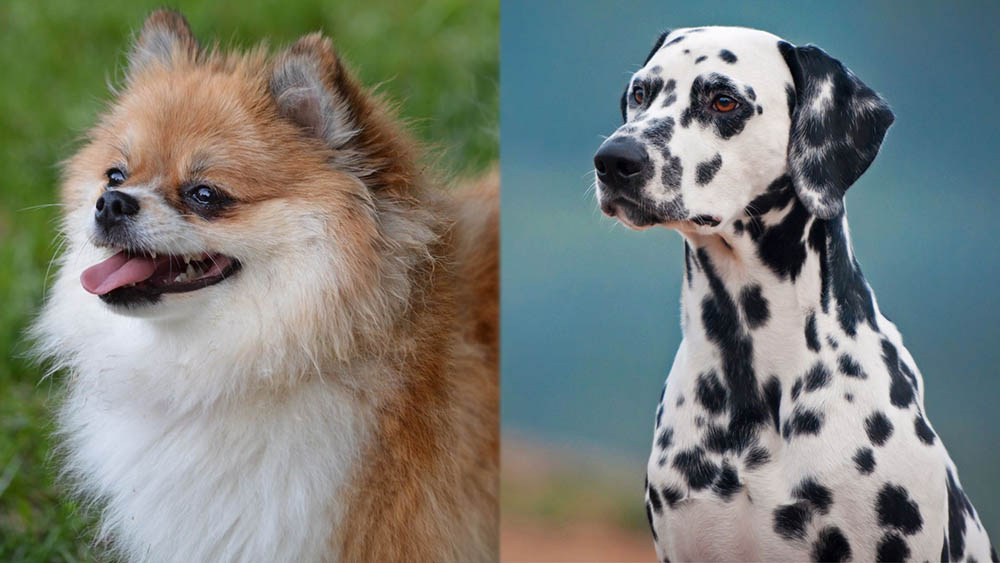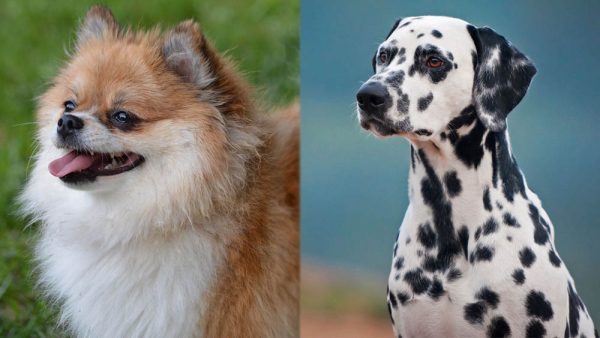Click Below to Skip Ahead
The Pomeranian Dalmatian mix is a unique crossbreed that combines the best traits of both parents. This hybrid is rare, likely due to the size difference between the two parent breeds. However, you can find a Pom Dalmatian puppy if you have enough patience and know where to look. Keep reading to learn more about this rare hybrid to see if it will be worth the time that it will take you to find one up for adoption.
Breed Overview
Height:
8–23 inches
Weight:
5–44 pounds
Lifespan:
10–16 years
Colors:
Orange, cream, sable, red, brown, black, blue, black spots, liver brown spots
Suitable for:
Active families, families with older children
Temperament:
Active, energetic, playful, affectionate, loyal
The Pomeranian Dalmatian Mix is a unique crossbreed that you don’t see every day. They’re so rare, in fact, that we were unable to find any breeders during our research. It’s much more common to find Pomeranians mixed with other small breeds, like a Chihuahua to get a Pomchi or a Poodle to get a Pomapoo. As for a popular Dalmatian mix, the Bodacion is a great mix of Border Collie and Dalmatian.
Pomeranian Dalmatian Mix Breed Puppies
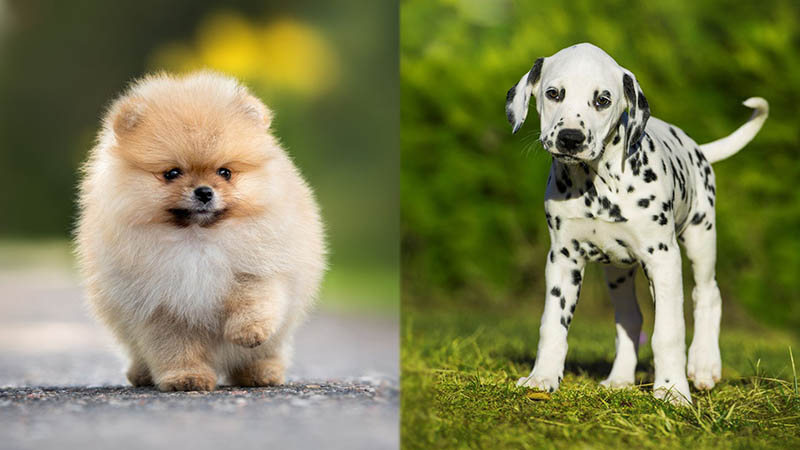
Pomeranian Dalmatian puppies are a challenge to find, as this is a rare hybrid. However, you may find a breeder specializing in this crossbreed or even stumble across a Pom Dalmatian puppy at your local shelter.
These puppies combine the best of the Pomeranian and Dalmatian breeds. They must be trained and socialized early to ensure that they grow into well-behaved adult dogs. A poorly trained Pom Dalmatian may be aggressive and fiery with a seriously stubborn streak.
Temperament & Intelligence of the Pomeranian Dalmatian Mix 🧠
As with any mixed breed, the temperament of a Pomeranian Dalmatian Mix can vary wildly from puppy to puppy. However, we can guess what the personality could be like based on the parent breeds.
A Pomeranian Dalmatian is likely to be active, playful, and intelligent like their parents. They will probably be highly affectionate toward their humans and outgoing and friendly toward strangers. Regardless of whether they take after their Pom or Dalmatian side, this hybrid pup is likely to make a great watchdog for your family and property. Both breeds are known for always keeping a vigilant eye and ear out for danger.
Are These Dogs Good for Families?
If your Pomeranian Dalmatian takes after their Dalmatian side more, they will make a fantastic pet for families with children. However, they may be highly energetic, which can present a problem in households with young children. A Pomeranian Dalmatian can weigh as much as 70 pounds if they lean toward their Dalmatian side, making it easy for them to injure small children unintentionally.
Don’t worry if your Pomeranian Dalmatian is more like their Pomeranian parent, though; they can still be a great fit for the right family. However, if they’re on the smaller side of the spectrum, they may be at risk of getting injured if the children do not yet know boundaries or how to handle a smaller pup.
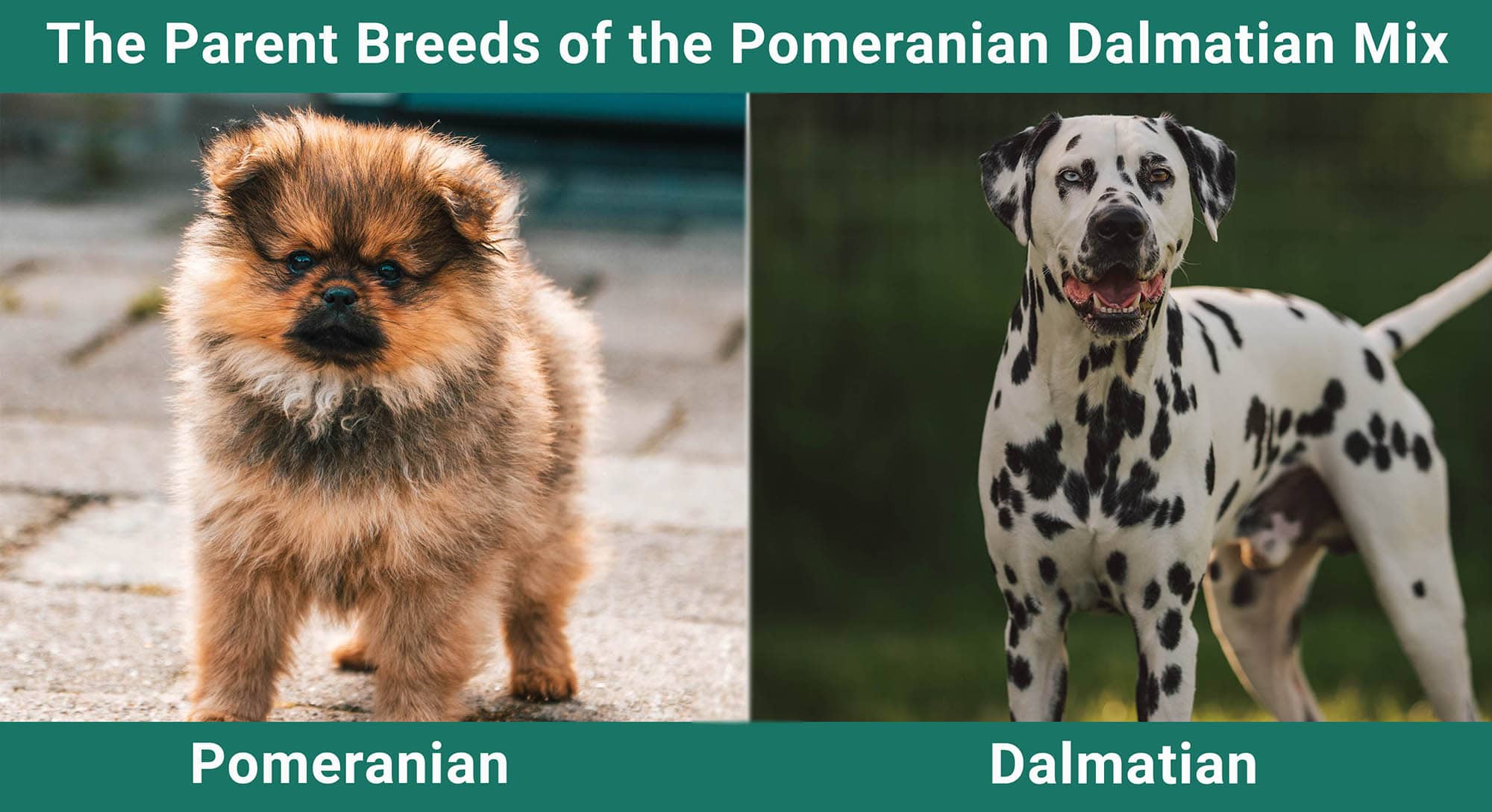
Does This Breed Get Along With Other Pets?
The Pomeranian Dalmatian will generally get along with other pets, though there may be exceptions to this rule.
If your pup takes after their Pom parent in size, tread carefully introducing them into a household with a large or extra-large dog breed that could injure them accidentally due to their size differences.
Your Pomeranian Dalmatian can live harmoniously with cats, provided your pup has been socialized and the two animals have a proper introductory period.
Things to Know When Owning a Pomeranian Dalmatian Mix
Food & Diet Requirements
A Pomeranian Dalmatian mix will require the same high-quality diet as any other dog breed. You should feed them size-specific food depending on which side of their ancestry they take after. Large and small dog breeds have different nutritional needs, so consider the size of your pup when considering their diet.
Small dogs like Pomeranians may need more calories per pound than their larger counterparts due to their higher metabolic rates. Dalmatians are considered medium-sized and should be fed a diet with precise nutrition for dogs in the 23- to 55-pound range.
Also, Dalmatians in particular are at a high risk of developing urinary stones, as they have a naturally high level of uric acid. You should never feed table scraps to your mix. Additionally, your vet may recommend a low-purine diet to help prevent urate bladder stones.
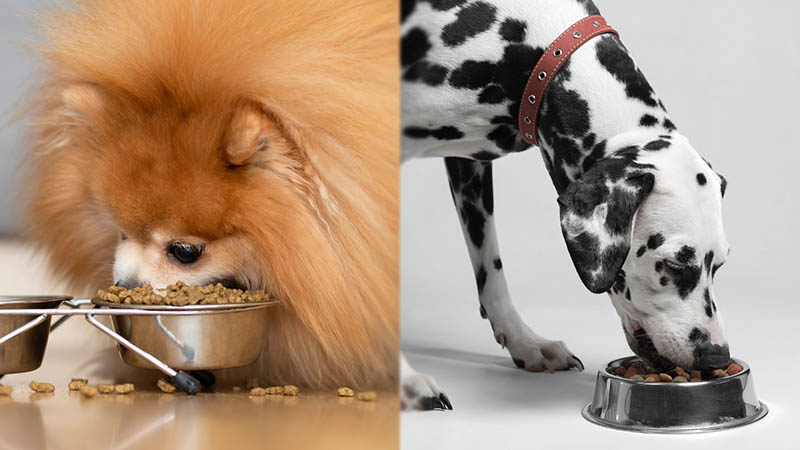
Exercise
A Pomeranian Dalmatian’s exercise needs can depend on your pup’s size and energy level. Since their parent breeds are lively and energetic, you should expect your dog to be the same. If they’re on the smaller side, you must commit to at least 30 minutes of daily exercise. If your pup takes after their Dalmatian side more in size and energy, you’re looking at a minimum of 90 minutes of exercise daily.
Exercise for a smaller Pom Dalmatian will most likely come in the form of two walks at a brisk pace. For a medium-sized pup, however, you’ll need to do more than a quick walk around the block. Aim for an hour of exercise twice daily, ensuring that your dog has time off the leash to free run.
Training
A Pomeranian Dalmatian is a highly intelligent dog that should be easy to train. However, considering that both of their parent breeds are prone to streaks of mischief, you may have your work cut out for you in some situations. They can be stubborn and willful, so you’ll need a certain firmness during training.
Positive reinforcement is always the easiest training method for dogs. A Pomeranian Dalmatian is likely to be food-motivated, so finding a delicious treat you can use as a high-value reward will get you far during your training sessions.
Grooming ✂️
A Pomeranian Dalmatian requires a moderate amount of grooming, as their parent breeds are both notorious shedders.
Pomeranians have thick double coats that shed a lot, especially during the spring and summer when they blow their coats. Dalmatians have short, dense coats. Even though their fur is short, they still shed heavily. They don’t blow their coats like Pomeranians but will shed throughout the year without much of a break.
You’ll need to brush your Pom Dalmatian’s coats daily to stay on top of shedding. We also recommend investing in a high-quality vacuum to control the hair in your home. Baths should be given as needed, but not too often that you dry out your pup’s skin.
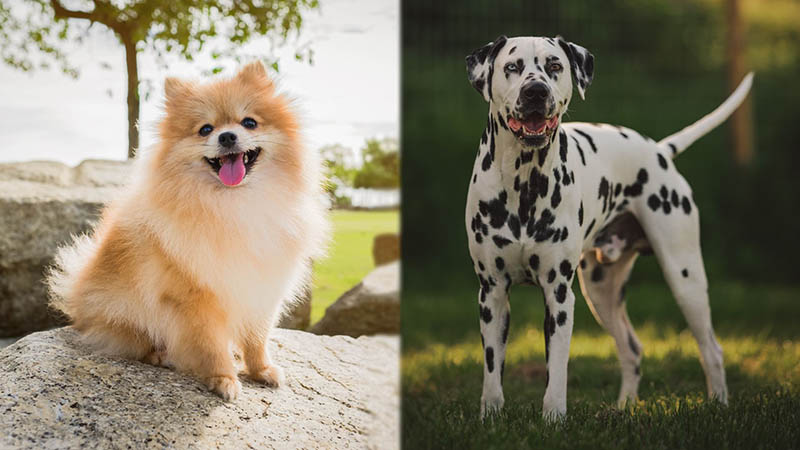
Health and Conditions
A Pomeranian Dalmatian may be at risk of developing any of the health conditions of their parent breeds.
Pomeranians may be prone to hypoglycemia, collapsing trachea, dental disease, hip dysplasia, Legg-Perthes disease, patellar luxation, and eye conditions like cataracts and dry eye. Dalmatians may be prone to developing bladder stones, deafness, dilated cardiomyopathy, and Dalmatian bronzing syndrome.
- Hypoglycemia
- Tear duct issues
- Cataracts
- Distichiasis
- Dental disease
- Patellar luxation
- Deafness
- Dalmatian bronzing syndrome
- Bladder stones
- Dilated cardiomyopathy
- Collapsing trachea
Male vs. Female
As with most dogs, male Pomeranian Dalmatian mixes tend to be larger, heavier, and stronger than their female counterparts.
Personality differences can depend on which parent breed the pup takes after more. Female Dalmatians, for example, are often easier to control and less headstrong than males. Males have much energy and can exhibit aggressive behavior toward other male dogs. Male Pomeranians are often more playful, exuberant, and friendly than females, which can be more territorial and possessive toward their family members.
3 Little-Known Facts About the Pomeranian Dalmatian Mix
1. Both breeds have origins in Europe
Dalmatians can be traced back to present-day Croatia and Dalmatia, one of Croatia’s four historical regions. Pomeranians originated in Pomerania, a region split between Germany and Poland in Central Europe.
2. Both breeds were originally bred to work
Dalmatians were used as sentinels at the borders of Dalmatia and Croatia during times of war. They’ve also been used as herding, ratting, and hunting dogs throughout history.
Pomeranians were originally bred to do hard labor and act as guard dogs. As silly as that may seem now with the modern-day Poms, the original stock was much bigger, around 30 pounds.
3. Both breeds change in appearance as they grow
Newborn Dalmatians are born all white. While the number and position of spots are set from birth, young Dalmatians don’t start getting their trademark spots until they’re 2 weeks old. The spots continue to develop until they’re around 2 years old.
Pomeranian puppies go through a fur color change when transitioning from puppyhood to adulthood. This transition lasts several months and is not-so-affectionately called the “Pomeranian puppy uglies.”
Conclusion
The Pomeranian Dalmatian mix is a unique and rare hybrid that couples the best traits of two popular breeds. Like their parents, these pups are likely to be friendly, energetic, playful, and affectionate. They’re also highly intelligent and may be prone to bouts of stubbornness. As with all dogs, proper training and socialization from a young age are essential for producing a happy, healthy, well-behaved pup.
Related Reads:
Featured Image Credit: (L) Trent Pickering, Unsplash | (R) Maria Ivanushkina, Shutterstock

